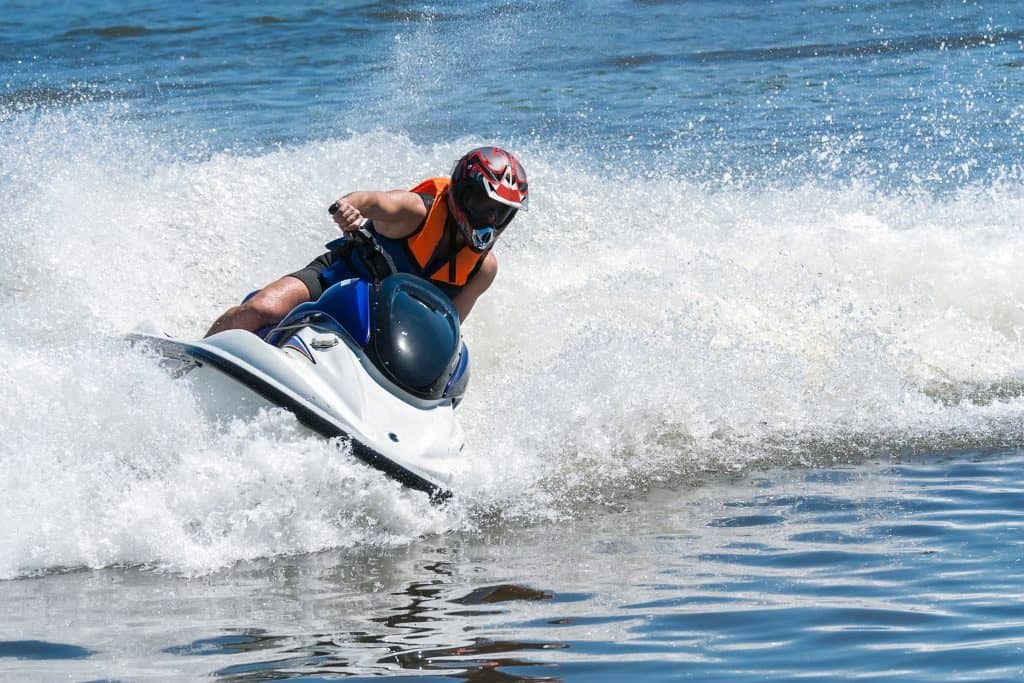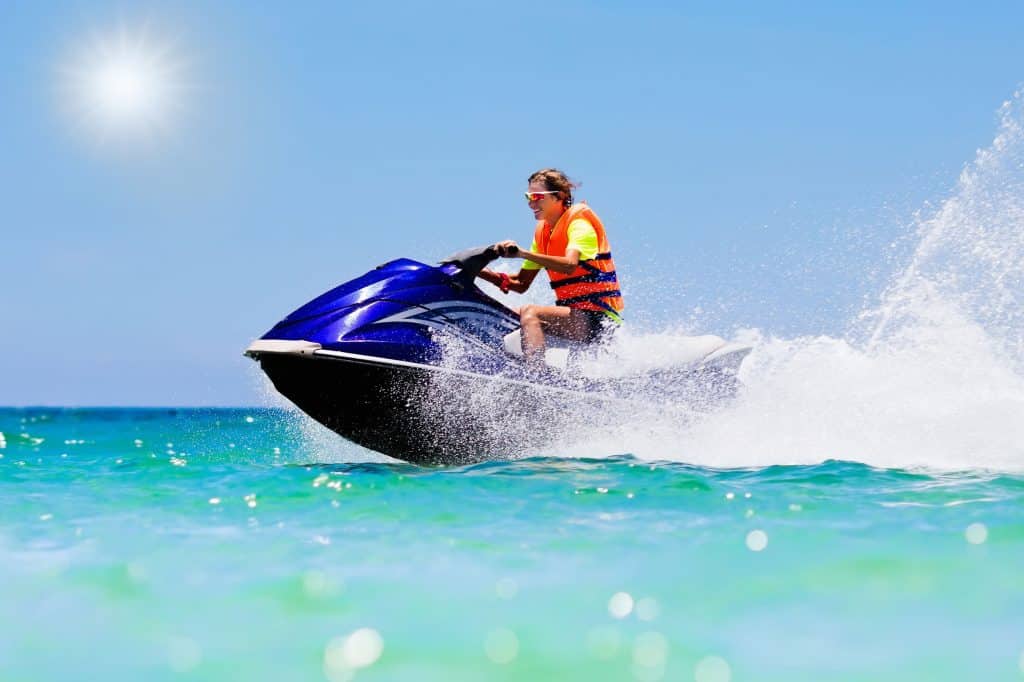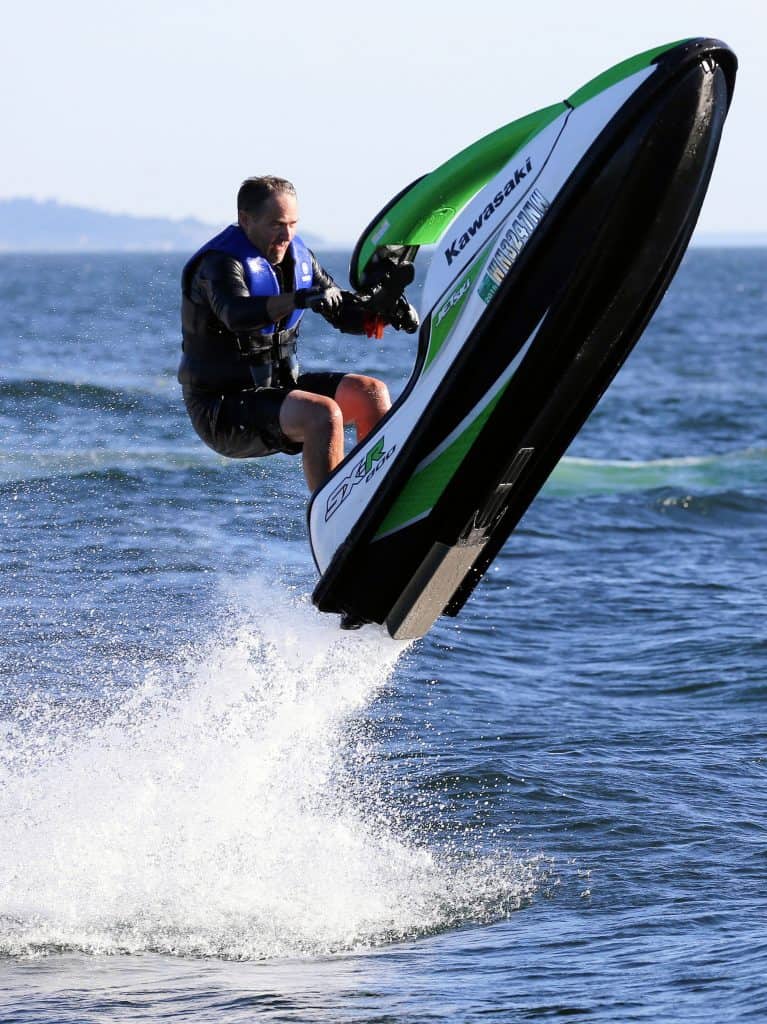
Jet skiing in the summertime is a great way to make some cherished memories with family and friends. To make sure you do not come across any bumps with law enforcement while on the water you will need to know the rules and regulations for jet skiing in the state of Arkansas. These rules can vary from state to state but it is a need-to-know in order to enjoy your time.
You need to obtain to an Arkansas Boater Education card to be able to use a PWC legally in the state of Arkansas. You also need to be 12 years old to be able to use a motorized vessel with a horsepower of 10 or more. In order to be able to operate a PWC on your own, you need to be 16 years old.
It is important to be aware of the following regulations and laws for riding a jet ski on the water within the state of Arkansas. By doing so you are responsibly following the law and that will guarantee you have an adventurous and stress-free time on your jet ski with family and friends.
Registering Your PWC
Arkansas Registration Fees
Registration Renewal Fees
- Less than 16 feet: $7.50
- 16 ft to 26 ft: $15.00
- 26 ft to 40 ft: $51.00
- 40 ft and longer: $105.00
Registration transfer fee: $2.00
Replacement registration fee: $1.00
Hull Identification Number
A Hull Identification Number (HIN) is a 12 digit number that is assigned by the manufacturer to vessel built after the year 1972. HIN helps be able to determine the differences between other vessels and identify the owner as well.
In case your vessel is stolen you should write down your HIN and place it somewhere safe and secure.
Numbers and Stickers
Once you receive your registration number and the validation stickers you must display these items in the following ways:
- there cannot be any other numbers shown on the bow of your vessel
- the letters have to separate from the numbers with a hyphen or space
- the color of your numbers must also be in contrast to the color of your vessel
- each number must be in block letters and three inches high
- the numbers must be read from left to right on both sides
- each number should be painted, applied onto your vessel as a decal, or place to be shown on both sides of the bow

The Basics
Operating a PWC Recklessly
RECKLESS OPERATION
Reckless operation of a PWC is not allowed. Examples of this are:
- Jumping a wake too close to another vessel
- Weaving through vessel traffic carelessly
- Swerving last minute to avoid collision with another vessel
- Carrying more passengers on your PWC than is recommended
- If you maneuver your PWC in a way that it causes harm to you or your passengers
NEGLIGENT OPERATION
- Not paying enough attention to how you or the operator is handling the vessel
- Failing to observe the navigational rules
- Never keeping a proper lookout
- Handling your vessel in such a way that it collides with another vessel
- Operating a motorboat that has a lanyard-type ignition safety switch without attaching the lanyard to your clothing or personal flotation device
GROSSLY NEGLIGENT OPERATION
Operating a PWC or manipulating water skis, aquaplane, or any other devices that can result in a serious injury or even death.
IMPROPER SPEED OR DISTANCE
- When you operate your vessel at a faster speed than recommended you are putting those around you and yourself at risk for getting hurt
- especially during vessel traffic, poor weather condition, and closeness to shore. You need to follow the speed regulations.
- If you are operating your vessel faster than 5 mph while operating within 100 feet of the shore, dock, pier, raft, float, or an anchored or moored vessel you are operating your vessel improperly and putting others around you at risk
Examples of this are:
- operating your vessel at extreme speed in the close vicinity of another vessel, PWC, or dangerous waters
- going a speed that can be harmful to your vessel
- operating at a greater speed than “slow, no wake” speed that is posted in a “no wake” zone
- going faster than the speed limit posted near the body of water you are operating on
OVERLOADING OR OVERPOWERING
This is when your overloading or overpowering the vessel you are operating over the capacity it can hold. It is also illegal to load a vessel without a capacity plate in an unsafe manner and that can result in your vessel sinking.
RIDING ON THE BOW OR GUNWALE
- Riding on anything that is not equipped with fixed seating can lead to the potential of falling overboard. Do not allow your passengers or yourself to sit on the seat back, transom, gunwale, or on seats on raised decks or a bow.
Alcohol and Drugs
In the state of Arkansas, you are considered to be under the influence if:
- have a blood alcohol concentration of 0.08% or more (if you are under the age of 21 and you have a blood alcohol concentration of 0.02% you are considered intoxicated)
- under the influence of alcohol or a controlled substance to a degree where you are acting differently than you usually do and if your motor skill are impaired
The following penalties are enforced when you are convicted of boating under the influence:
- On your first offense you will be fined up to $1,000 and be sentenced to jail for up to a year. You will also lose your ability to operate a vessel or motorboat for 90 days.
- On your second offense (within three years) you will be fined $2,500 and be sentenced to jail for a year. Your privilege to operate a motorboat will be suspended for a year.
- Upon your third offense (within three years) you will be fined $5,000 and be sentenced for no less than 60 days and you can stay for up to one year. You will also lose your ability to operate a motorboat for three years.
In addition to any of those penalties anyone convicted of the following will have to complete an alcohol education program that is approved by the Arkansas Highway Safety Program.

Required Equipment
Personal Flotation Devices
| Type 1 | Offshore Life Jackets | This vest can turn an unconscious person in the water to face up in the water. It was made for rough waters and for situations where rescue might take a long time. |
| Type 2 | Near-Shore Vests | This vest is fit for calmer waters and faster rescues. If you were to wear this while unconscious it may not be able to turn your face up in the water. |
| Type 3 | Flotation Aids | This vest can also be a full-sleeved jacket and it is great for calm waters and fast rescues. This will definitely not turn your face up in rough waters. This is generally worn for water sports. |
| Type 4 | Throw able Devices | This type of flotation device is a cushion or ring buoys and are typically used to throw at someone in trouble. They are not made to last for long hours in the waters, or non-swimmers, or the unconscious. |
| Type 5 | Special-Use Devices | This type of flotation device was made for activities like kayaking, water-skiing These typically look like white water vests, deck suits, and personal flotation device hybrids. |
PFD Requirements
- Guard, must be on board a vessel that is 16 feet or longer and it must also be easily accessible for emergency use
- Vessels have to have 1 of the 5 personal flotation devices on board and they also must be a wearable size for any passenger or operator
- Any person that is on board a PWC or vessel (no matter their age) must wear a personal flotation device
Fire Extinguishers
You can classify your fire extinguishers by letter and number symbol. The number helps you decipher the size of the extinguishers, and the letter indicated the type of fire that is extinguishers as well.
| TYPE A FIRES | These types of fires are combustible solids such as wood |
| TYPE B FIRES | These types of fires are flammable liquids like gasoline or oil |
| TYPE C FIRES | This type of fire is mainly electrical fires |
These fire extinguishers must stay in usable condition. You need to regularly check up on the extinguishers to ensure they are in the best condition:
- there is no physical damage, corrosion, leakage, or clogged nozzle
- seals and tamper indicators are not broken or missing
- pressure gauges or indicators are not broken or missing
What to do in an Accident
In the event of an accident occurring while you or another person is using a PWC. The operator must submit a written accident report if one of the following happens…
- A person disappears from the vessel and it may indicate possible death or injury
- A person dies
- A person is unable to perform normal or usual activities
- There is damage to the vessel or other property damage and it totals to more than $2,000 or if there is a complete loss of the vessel
Law Enforcement
The boating laws of Arkansas are enforced by the Arkansas Game & Fish Commission enforcement officers, sheriffs, deputy sheriffs, state police officers, and the Department of Parks and Tourism enforcement officers.
